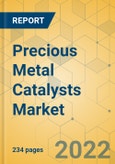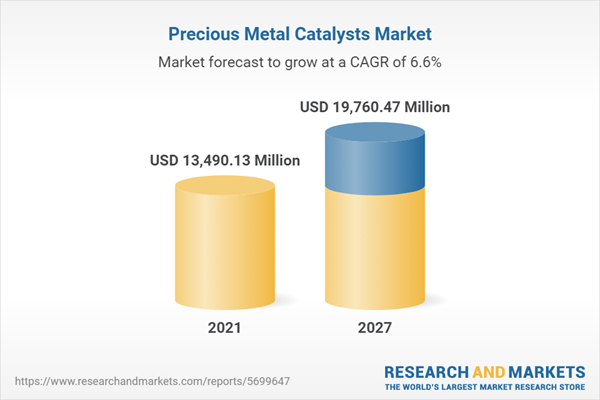Speak directly to the analyst to clarify any post sales queries you may have.
Precious metal catalysts are the metal substances used for the increasing rate of a chemical reaction by offering oxidation and carrion resistance properties. Six precious metal catalysts come from platinum group metal (PGM), such as platinum, palladium, rhodium, ruthenium, iridium, and osmium. The precious metal catalyst is also called a noble metal catalyst. These are used in various industries for various purposes, such as in the pharmaceutical industry; these are used in manufacturing drugs for DNA/RNA treatment, cancer, heart-related disease, and other treatments.
Precious metal catalysts are used in various pharmaceutical, automotive, aerospace, oil & gas, agrochemical, and other industries. Due to emerging technology, sustainability is increasing all over the world. Companies are adopting sustainable standards in their manufacturing processes. To improve sustainability, the companies are training their suppliers and improving supplier's sustainability and found that they are getting good financial returns from such investments. Companies have started using precious metal catalysts instead of chemical catalysts to improve sustainability. Thus, boosting the growth of the precious metal catalysts market.
MARKET DRIVERS & OPPORTUNITIES
Increase in Investment in Refinery Sector and Increasing Environmental Concern
- Precious metal catalysts are beneficial in reducing carbon emissions in the oil & gas industry. In the conversion method of oil refining, catalysts are required for cracking hydrocarbons and converting them into lighter molecules. Platinum, Ruthenium, Palladium, and Rhodium are the precious metals catalyst used in the catalytic reaction process in oil & gas, thereby boosting the precious metal catalysts market growth.
- The increasing demand for natural resources and fossil fuels is causing biodiversity loss and environmental degradation. Further, in the water sector, dumping human and industrial waste, including personal care and pharmaceutical products, in the water is causing increased contamination levels. Also, after the COVID-19 pandemic, people are focusing on the role of air pollution & hazardous gases. Even the government has restricted air pollution and has given regulatory norms. Due to this, various companies have increased the usage of precious metal catalysts in their production, which helps to reduce carbon emissions.
Increasing Demand from Automotive
- Combustion engines play a crucial role in the automotive industry for operating vehicles. In combustion engines, the fuel is used for producing large amounts of energy. Primarily hydrocarbons are used as a fuel in the combustion engine. In combustion engines, hydrocarbons have polluting substances and harmful chemicals such as nitrogen oxide and carbon monoxide. Platinum, palladium, and rhodium metal catalysts reduce carbon emissions from motor vehicle exhaust, boosting the global precious metal catalysts market share in the automotive industry.
INDUSTRY CHALLENGES
Precious Metal Catalysts Price Volatility
- The fluctuation in the price is a big challenge for companies that work in the precious metal catalysts market. They are the restraints that affect the success of the business, such as competitiveness, capital commitment, and margin, as per the secondary data of Heraeus Holding. Handling this volatility in the price of precious metals is very crucial. It requires the right conditions, such as expertise, time, and experience.
- Platinum and other metals are rare; thus, the price is higher than gold. Also, the usage of platinum is high in the jewelry industry, and its demand is increasing from the automotive industry to reduce carbon emissions in motor vehicles. With the changing government regulations about carbon emissions, companies focus on lowering carbon emissions. Thus, platinum metal catalyst usage is increasing, accounting for the price of precious metals. But, the disadvantage of investing in precious metals is that there will be no cash flow; thus, the investor will not receive income, making the price of precious metal catalysts volatile.
MARKET SEGMENTATIONS
INSIGHTS BY TYPE
The platinum precious metal catalyst market holds the largest market share and is expected to cross USD 8.52 billion by 2027. Platinum is a chemical element and a member of the platinum group metal. Platinum is a rare metal found in the earth’s crust. Due to these properties, the demand for the platinum metal is very high. Platinum catalysts are the most active catalyst in oxidization reactions. In motor vehicles, it is used to resist carbon emission in combustion engine exhaust.Palladium is the 2nd largest precious metal catalyst used in the world, as per the data from the US Department of Energy. In the oil & gas industry, palladium is used as a catalyst for running hydrocracking. Palladium metal catalyst is used to reduce the automotive industry's carbon emissions. It absorbs hazardous particles in the exhaust of the combustion engine. In alcohol production, it is used for the oxidation of alkaline media.
Segmentation by Type
- Platinum
- Palladium
- Rhodium
- Ruthenium
- Other
INSIGHTS BY END-USE
The global pharmaceutical precious metal catalysts market is the largest segment under end-use, growing at a CAGR of 6.84% during the forecast period. The high share of the pharmaceutical segment is attributed to the demand for pharmaceutical products being expected to grow significantly during the forecast period. The pharmaceutical industry uses catalysts for molecular biology, medically important extraction compounds, diagnostic procedures, chemical pharmaceutical manufacturing, and deficiencies supplements. There is a massive demand for the precious metal catalysts used in drug manufacturing to treat infectious diseases. Further, the demand for pharmaceutical products is increasing due to the rapidly growing population and changing variants of chronic diseases.The global oil & gas precious metal catalysts market was valued at USD 3.718 billion in 2021. The industry is growing rapidly after the COVID-19 pandemic. The global demand for gasoline oil is very high due to increasing usage in various industries. Further, the palladium, platinum, ruthenium, and rhodium catalysts are used in the catalytic reactions in the oil & gas industry. For separating gasoline from heavier oils, catalysts play a crucial role.
Segmentation by End-Use
- Pharmaceutical
- Oil & Gas
- Automotive
- Other
GEOGRAPHICAL ANALYSIS
APAC holds the largest global precious metal catalysts market share, accounting for 44.46% in value. The region is led by China, India, Japan, South Korea, and others, where the penetration of precious metal catalysts is very high, and revenue has been increasing steadily. The rapidly developing infrastructure, readily increasing population, and growing demand from various industries such as pharmaceutical, automotive, oil & gas drive the region’s growth.North America's precious metal catalysts market was valued at USD 3.4 billion in 2021 and was the second-largest industry. The region is one of the largest producers of vehicles. US & Canada are the major markets in the global automotive industry. Thus, the region's demand for platinum & palladium catalysts is increasing rapidly. Alfa Chemistry (US) and Sabin Metal Corporation (US) are significant companies that produce platinum & palladium catalysts for usage in agricultural chemicals. Europe’s precious metal catalysts market is growing with a CAGR of 5.38 during the forecast period. The region was led by countries like Germany, France, Italy, Spain, the UK, and others. The demand for pharmaceutical products is increasing in Europe due to growing infectious diseases, pushing the demand for precious metal catalysts in the region.
Segmentation by Geography
- Europe
- Germany
- France
- Italy
- Spain
- UK
- Rest of Europe
- North America
- US
- Canada
- APAC
- China
- Japan
- South Korea
- India
- Rest of APAC
- Latin America
- Brazil
- Mexico
- Rest Of Latin America
- Middle East & Africa
- Saudi Arabia
- South Africa
- Rest of MEA
VENDOR LANDSCAPE
The major companies in the precious metal catalysts market follow the merger and acquisition strategy; this gives companies a competitive advantage that boosts the market share of the company. The key companies have undertaken various strategies to grow in the precious metal catalysts market. Investments in R&D, technological advancement, and environmental and economic challenges are driving the demand for innovative and sustainable precious metal catalysts products. Companies in the market are competing strategically, whereas growth in a sustainable manner has been a challenge for all companies globally.Some major players in the global precious metal catalysts market include BASF SE (Germany), Johnson Matthey (UK), Evonik (Germany), Umicore (Germany), and Heraeus Holding (Germany). These players have adopted expansion, acquisitions, new product development, joint ventures, and others to increase their market revenues. Furthermore, other prominent companies such as Clariant (Switzerland), American Elements (US), Kaili Catalysts (China), Dyadic International (US), and others have invested significant capital in R&D to develop precious metal catalysts-based products that will appeal to the customers. Therefore, these other prominent companies are giving tough competition to major companies.
Key Vendors
- BASF SE
- Evonik
- Johnson Matthey
- Heraeus Holding
- Umicore
Other Prominent Vendors
- Alfa Chemistry
- American Elements
- Arora Matthey Limited
- Clariant International Ltd.
- Chimet S.p.A.
- Dongguan City Betterly New Materials Co., Ltd.
- Halder Topsoe A/S
- J&J Materials Inc.
- Kaili Catalyst New Materials CO., LTD
- N.E. Chemcat Corporation
- Synthesis with Catalysts Pvt. Ltd. (SWC)
- Sabin Metal Corporation
- Souvenier Chemicals
- Stanford Advanced Materials
- Takasago International Corporation
- Vineeth Precious Metal Catalysts Pvt. Ltd.
KEY QUESTIONS ANSWERED
1. What is the revenue forecast for the global precious metal catalysts market?2. What is the growth rate of the precious metal catalysts market?
3. Who are the key players in the global precious metal catalysts market?
4. Which region dominates the global precious metal catalysts market?
5. What are the key driving factors in the precious metal catalysts market?
Table of Contents
Companies Mentioned
- BASF SE
- Evonik
- Johnson Matthey
- Heraeus Holding
- Umicore
- Alfa Chemistry
- American Elements
- Arora Matthey Limited
- Clariant International Ltd.
- Chimet S.p.A.
- Dongguan City Betterly New Materials Co., Ltd.
- Halder Topsoe A/S
- J&J Materials Inc.
- Kaili Catalyst New Materials CO., LTD
- N.E. Chemcat Corporation
- Synthesis with Catalysts Pvt. Ltd. (SWC)
- Sabin Metal Corporation
- Souvenier Chemicals
- Stanford Advanced Materials
- Takasago International Corporation
- Vineeth Precious Metal Catalysts Pvt. Ltd.
Methodology
Our research comprises a mix of primary and secondary research. The secondary research sources that are typically referred to include, but are not limited to, company websites, annual reports, financial reports, company pipeline charts, broker reports, investor presentations and SEC filings, journals and conferences, internal proprietary databases, news articles, press releases, and webcasts specific to the companies operating in any given market.
Primary research involves email interactions with the industry participants across major geographies. The participants who typically take part in such a process include, but are not limited to, CEOs, VPs, business development managers, market intelligence managers, and national sales managers. We primarily rely on internal research work and internal databases that we have populated over the years. We cross-verify our secondary research findings with the primary respondents participating in the study.

LOADING...
Table Information
| Report Attribute | Details |
|---|---|
| No. of Pages | 234 |
| Published | December 2022 |
| Forecast Period | 2021 - 2027 |
| Estimated Market Value ( USD | $ 13490.13 Million |
| Forecasted Market Value ( USD | $ 19760.47 Million |
| Compound Annual Growth Rate | 6.5% |
| Regions Covered | Global |
| No. of Companies Mentioned | 21 |









